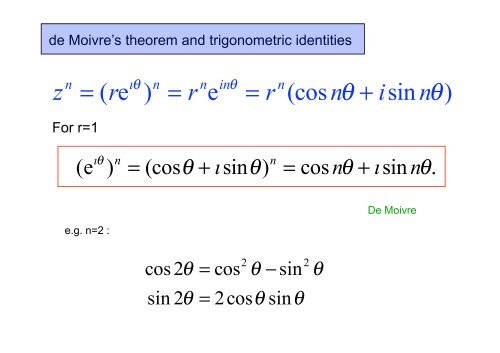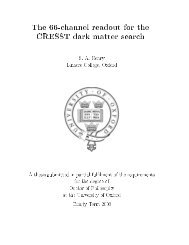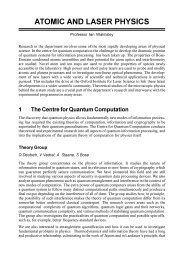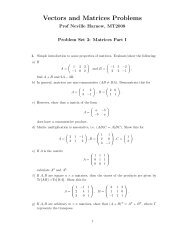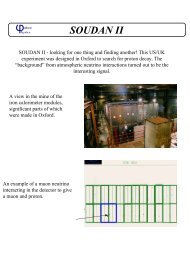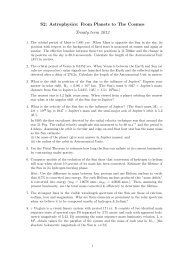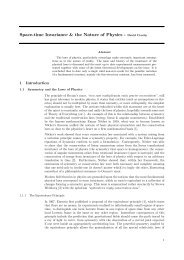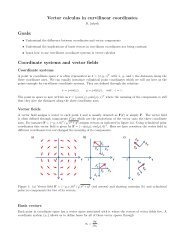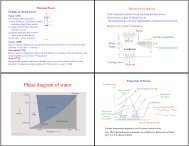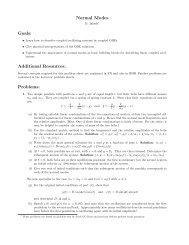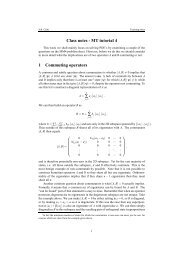Complex numbers 3
Complex numbers 3
Complex numbers 3
Create successful ePaper yourself
Turn your PDF publications into a flip-book with our unique Google optimized e-Paper software.
de Moivre’s theorem and trigonometric identities<br />
z n = (re ıθ ) n = r n e inθ = r n (cos nθ + isin nθ)<br />
For r=1<br />
(e ıθ ) n = (cosθ + ısinθ) n = cos nθ + ısin nθ.<br />
De Moivre<br />
e.g. n=2 :<br />
cos 2 cos sin<br />
2 2<br />
θ = θ − θ<br />
sin 2θ = 2cosθ sinθ
Uses of de Moivre and complex exponentials<br />
Ex. 1 Find (1+ ı) 8<br />
. Taking powers is much simpler in polar form so we write<br />
. Hence<br />
ıπ /4<br />
(1+ ı) = (2) e<br />
.<br />
(1+ ı) 8 = ( (2) e ıπ /4 ) 8 = 16e 2πı = 16
Uses of de Moivre and complex exponentials<br />
Ex. 2<br />
Solving differential equations<br />
The solution to d 2 z<br />
d 2<br />
θ<br />
z = Ce iθ<br />
z = x + i y<br />
+ z = 0 is simply given by<br />
where C = A + ıB is a complex constant.<br />
y = Im(z) = Im(( A + ıB)(cosθ + ısinθ))<br />
= Asinθ + Bcosθ<br />
c.f.<br />
d 2 y<br />
d 2<br />
θ<br />
+ y ≡ Im( d 2 z<br />
+ z) = 0, v = Acosθ<br />
+ Bsinθ<br />
dθ 2
Uses of de Moivre and complex exponentials<br />
Ex. 3 Summing series<br />
e.g. Show<br />
∞<br />
∑<br />
n=<br />
0<br />
r<br />
n<br />
(1 r)sin<br />
sin(2n<br />
+ θ<br />
1) θ = +<br />
,<br />
2<br />
1 − 2r<br />
cos 2θ<br />
+ r<br />
0 < r < 1<br />
∞<br />
∑ r n sin(2n + 1)θ = Im∑ r n (e ı(2n+1)θ ) = Im(e ıθ<br />
∑ (re 2ıθ ) n )<br />
n=0<br />
n<br />
= Im(e ıθ 1<br />
1− re 2ıθ )<br />
e ıθ (1− re −2ıθ )<br />
= Im(<br />
(1− re 2ıθ )(1− re −2ıθ ) )<br />
sinθ + r sinθ<br />
=<br />
1− 2r cos2θ + r 2<br />
n
Curves in the complex plane<br />
Ex 1<br />
| z |=<br />
1<br />
iθ<br />
z re r<br />
= ⇒ =<br />
1, any<br />
θ<br />
or<br />
(a) 2 + (b) 2 = 1,<br />
z = a + ib<br />
Circle centre (0,0), radius 1<br />
| z − z |= 1 0<br />
Circle centre z 0 , radius 1<br />
( a − a ) + ( b − b ) = 1<br />
2 2<br />
0 0
Curves in the complex plane<br />
Ex 2<br />
| z −ı<br />
z +ı |= 1<br />
| z − i | = | z + i |<br />
Distance from (0,1) = distance from (0,-1)<br />
Real axis<br />
or (a) + ( b − 1) = (a) + ( b + 1)<br />
2 2 2 2<br />
z = a + ib<br />
b<br />
=<br />
0, a arbitrary
Curves in the complex plane<br />
Ex 3<br />
arg( )<br />
z π<br />
z+ 1<br />
=<br />
4<br />
i.e. arg(z) − arg(z + 1) = π 4<br />
Take tan of both sides :<br />
tan( A − B) =<br />
tan A − tan B<br />
1+ tan Atan B<br />
b<br />
a<br />
−<br />
b<br />
1 + .<br />
a<br />
b<br />
a+<br />
1<br />
b<br />
a+<br />
1<br />
b( a + 1) − ba<br />
= 1 =<br />
2<br />
a( a + 1) + b<br />
b = a( a + 1) + b<br />
2<br />
z = a + ib<br />
( a + ) + ( b − ) =<br />
1 2 1 2 1<br />
2 2 2<br />
…but BEWARE…not all of circle satisfies equation…
arg( )<br />
z π<br />
z+ 1<br />
=<br />
4<br />
z<br />
z + 1 =<br />
z<br />
z + 1 . z * +1<br />
z * + 1 = z(z* + 1)<br />
z + 1 2<br />
=<br />
(a + ib)(a + 1− ib)<br />
z + 1 2<br />
= a(a + 1) + b2 + ib<br />
z + 1 2<br />
⇒<br />
⎛<br />
b > 0 since arg<br />
⎝<br />
⎜<br />
z ⎞<br />
z + 1⎠<br />
⎟ positive<br />
(a + 1 2 )2 + (b − 1 2 )2 = 1 2 , b > 0<br />
( b < 0 solution introduced by tangent ambiguity)
Alternative solution<br />
arg( )<br />
z π<br />
z 1 4<br />
+<br />
= i.e. arg(z) − arg(z + 1) = π 4<br />
Solution : portion of circle through (0,0) and (-1,0)<br />
Circle centre (-1/2,1/2) and radius 1/ 2
The lower portion of the circle is given by :<br />
arg(<br />
+<br />
) = −<br />
z 3π<br />
z 1 4


